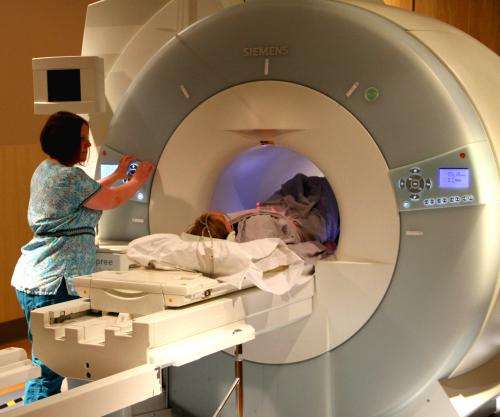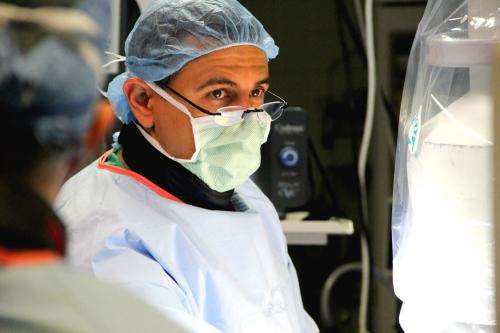Ohio State's Wexner Medical Center implants one of first MRI-safe devices for pain

Neurosurgeons at The Ohio State University Wexner Medical Center are among the first in the United States to successfully implant an MRI-safe spinal cord stimulator to help patients suffering from chronic back or limb pain.
Neurosurgeons Dr. Ali Rezai and Dr. Milind Deogaonkar performed the surgery Aug. 5 to help relieve intense foot pain due to a peripheral neuropathy that 78-year-old John Garvin of Worthington, Ohio, has suffered for more than 20 years. Garvin is among the estimated 100 million Americans living with chronic pain, according to the Institute of Medicine of the National Academies
For some patients, such as Garvin, relief comes only through a stimulator device implanted near the spine to help block pain signals to the brain. These stimulators have been used for years, but in the past, once they were implanted, patients could no longer receive Magnetic Resonance Imaging (MRI) screenings. That worried Garvin, who has needed MRI scans in the past.
The Food and Drug Administration recently approved the RestoreSensor SureScan MRI neurostimulation system developed by Medtronic Inc., for use in the treatment of chronic, intractable back or limb pain for conditionally safe full-body MRI scans, under specific conditions.
"The ability to safely perform MRI scans after spinal cord stimulator implant is an important advance and a major benefit for our patients," said Rezai, director of the Center for Neuromodulation and Functional Neurosurgery at Ohio State's Wexner Medical Center. "Now, with this new capability, we're able to perform MRI scans of the body for our patients who have implants and that provides a better way for patients to be managed over time."

MRI scans have become a diagnostic standard of care, allowing physicians to detect a wide range of health conditions by viewing highly detailed images using strong magnetic fields and radio frequency pulses to create images of structures in the body. Worldwide, it's estimated that 60 million MRI procedures are performed each year, including an estimated 32 million in the United States,
"MRI examinations are necessary and routinely performed for diagnosis and clinical care. It's very likely that a patient with chronic pain, spinal disease, neurological and orthopedic disorders will require an MRI scan," said Rezai, who is president of both the North American Neuromodulation Society and the Congress of Neurological Surgeons. "These spinal cord stimulators can help patients who suffer from extreme back, leg and extremity pain, especially those patients who have failed all previous medications and other approaches to get improvements in their pain and quality of life and functioning.
Ohio State neurologist Dr. John Kissel, a neuromuscular specialist, who has treated Garvin for almost two decades, said he suggested Garvin for the surgery because multiple medications were no longer helping to relieve foot and leg pain caused by his diabetic neuropathy.
"The stimulator will improve his life by reducing his pain, increasing his ability to do routine activities, and hopefully lowering his need for medications," Kissel said.
Garvin is looking forward to spending pain-free time playing with his grandchildren, walking his dog and attending Ohio State football games.
"This is a no brainer," Garvin said. "I wouldn't continue on with this pain for 10 minutes longer than I'd have to before I could have it put in. I know I'll feel stronger because I'll be able to do more things without pain."
Until now, patients with spinal cord stimulators couldn't receive full-body MRI scans due to concerns about the system being affected by the large magnetic fields and radio frequency energy involved in an MRI scan. The new device is designed with enhancements to reduce or eliminate the hazards produced by the MRI. The system includes a proprietary feature which sets the neurostimulator to an appropriate mode for the MRI environment, enabling radiology staff to easily and conveniently confirm a patient's implantable system is safe for MRI scanning.
"At Ohio State, we're happy to be one of the first in the country to be able to implant this device that allows our patients to receive MRI scans safely," Rezai said

















